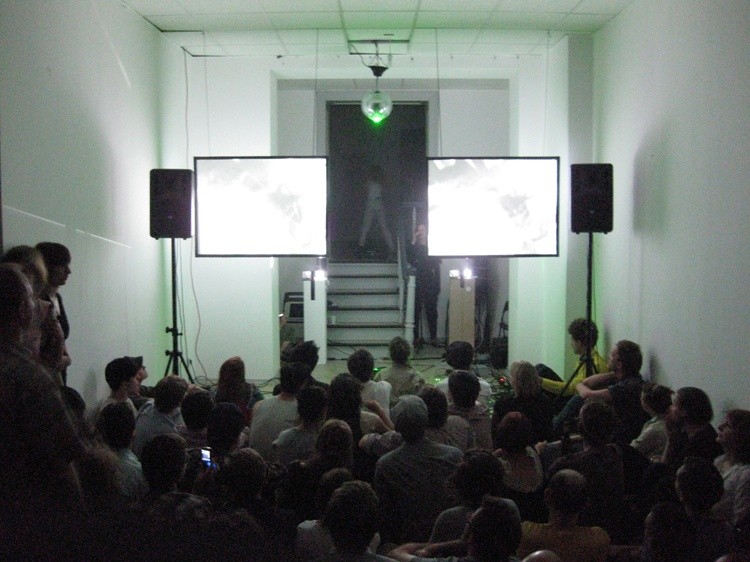AROUND THE WATER COOLER AT THE OFFICE'S FAR-FLUNG PERFORMANCES

Jeremy Shaw, Best Minds Part Two, 2009. Courtesy the artist
Throughout the month of July in Berlin, the curatorial team of Ellen Blumenstein, Katharina Fichtner, Maribel López, and Kathrin Meyer—collectively known as THE OFFICE—took this extra-institutional formula ambitiously further, staging a series of eleven performances in an unglamorous residential district near Alt-Moabit, west of the city's main train station. The four friends had been working for some time in the art scene (as gallerist, critic, rogue and institutional curator), more or less in Mitte, before developing a conceptual project that could engage with the city in a potentially new way—and especially during a season (high summer) essential to the city's culture when most of the established art venues have little new work to show. For The Performances, each woman approached one or several artists to develop a project for a 45-square-meter space on Lübeckerstraße (just down the street from the birthplace of German-Jewish writer Kurt Tucholsky) which THE OFFICE describe as a defunct front room adapted to "the classical in-between-use so typical of the 90s in Berlin."
In fact, such exhibition rooms are typical of Berlin's contemporary art community, but the terms limiting July's Performances were less so. Remoteness was not the only issue; timing was quite another. A prompt performance schedule necessitated unprecedented punctuality and the Tuesday/Friday/Sunday rhythm was sometimes relentless. Anyone arriving after 8 PM was not allowed in, for reasons of restricted capacity. An intimate, impermanent spectacle was precisely THE OFFICE's curatorial prerogative, making the traditional exhibition format seem a very lonely and isolated experience by comparison. It was particularly this captive and willing audience that was key to an otherwise diverse program, which made for an intensely focused, collective viewing environment—without the requisite clinking beer bottles or background chatter.
Icelandic artist Darri Lorenzen's opening performance forced together forty or so spectators standing shoulder-to-shoulder, barely breathing in light that waned into total darkness-then brightened incrementally again as two powerful smoke machines pumped fog thickly enough to induce spatial confusion. On a stair at the far end of the small space, a dancer grew slowly perceptible through a dense cloud that dissipated after several minutes, to everyone's shared relief. (LEFT: DARRI LORENZEN, VOID DOUBT ECHO, 2009)
The artist Jeremy Shaw, whose work is situated squarely between disciplines (in music, he is officially Circlesquare) was approached to take part in The Performances while on tour. Within a week, he presented a piece developed from his single-channel installation Best Minds Part One (2007), which uses video footage of teenage boys at a Straight-Edge Hardcore show (in North Vancouver, British Columbia) set to a soundtrack based on William Basinski's Disintegration Loops. For Part Two, Shaw tried his hand at cross-pollination with a strict deadline, and some curatorial prodding. What resulted was a culminating collusion of his parallel practices, complete with disco ball:
"What sent me in the direction of actually trying to bridge disciplines this time, was actually because that's sort of what THE OFFICE hinted they wanted me to do...I think I really needed the push from someone else to initiate an attempt as such—there's often lots of repeated references and mottos in both the music and art but I have generally kept them separate until now. And even still, that was more art to me, but yes, with a live climax in the middle. ... It's possible to do a lot more with 15 minutes of a captive audience than 50 with a night club crowd who talk when things get slow or go to the bar when they lose interest in the show...performance is somewhere you can truly test things out in a sort of alchemical way—and not have to be quite as confident in them as when putting them to tape, or up on a wall for a month."
A one-time-only lecture by Eric Bünger, comedic Powerpoint presentation by Miguel Noguera, micro-drama by Kerstin Cmelka, linguistically syncopated film by Daniel Mueller-Friedrichsen (the actors, in attendance, screened it for the first time, too) and others helped draw a bicycle-happy summer crowd from further downtown, to loiter on the pavement post-performance for sometimes upwards of three hours. Still, THE OFFICE garnered no neighborhood noise complaints, proving that when work is done well, there are rewards to reap. Ultimately, the curatorial constraint was difficult to contain: Matt Keegan and Dane Mitchell spilled into a nearby park, recruiting an awkwardly adolescent jump crew to rehearse while bratwurst grilled for the finissage. It was the last and perhaps most difficult performance, because so diffuse: The now emancipated audience ending the workday early before seasonal European August travel. Because vitality lasts only so long—or rather, because THE OFFICE's space was donated only temporarily by a local property management company—as of Monday the Lübeckerstraße storefront was back on the market, and the show finally over.
